| SBB-CFF-FFS RABDe 8/16 |
|---|
 SBB RABDe 8/16 in its original livery |
| Type and origin |
|---|
| Power type | Electric |
|---|
| Builder | |
|---|
| Build date | 1976 |
|---|
| Total produced | 4 |
|---|
|
| Specifications |
|---|
Configuration:
| |
|---|
| • UIC | Bo'Bo'+2'2'+2'2'+Bo'Bo' |
|---|
| Gauge | 1,435 mm (4 ft 8 1⁄2 in) |
|---|
| Length | 100,000 mm (328 ft 1.0 in) |
|---|
| Loco weight | 149 t (147 long tons; 164 short tons) |
|---|
|
| Performance figures |
|---|
| Maximum speed | 125 km/h (78 mph) |
|---|
| Power output | 2,250 kW (3,020 hp)
at 81 km/h (50 mph) |
|---|
| Tractive effort | - 100 kN (22,000 lbf) (continuous)
- 187 kN (42,000 lbf) (maximum)
|
|---|
|
| Career |
|---|
| Numbers | 2001 – 2004 |
|---|
| Last run | September 30, 1997 |
|---|
| Retired | 1997 |
|---|
| Preserved | 0 |
|---|
| Scrapped | 1998 |
|---|
|
The RABDe 8/16 are a consequential further development of the RABDe 12/12 multiple units used by the SBB-CFF-FFS. They were, like the RABDe 12/12, designed for quick acceleration in commuter traffic. But in contrast to the RABDe 12/12, they didn't reach this goal with a lot of motor power, but rather by having a lightweight aluminium construction. Four ordered prototypes were built, but already retired from service in 1997 and later scrapped. They are among the SBB-CFF-FFS vehicles with the shortest use period.
The trainsets originally had the numbers 1121–1124. Already during construction of the prototypes, the waggon floor bent "like a banana" - One of the reasons why they got the nickname "Chiquita". Another reason was their unique purple-yellow livery, captivating many railfans.
Starting 1976, the Chiquitas were used on the right-hand waterside of the Lake of Zurich. Due to massive problems mainly with the door controllers, which didn't work correctly because of the flexing floors, they were later used mainly on spur lines in north-eastern Switzerland (Kreis III). Despite being rarely used due to the problems, two trainsets (2001 and 2003) were rebuilt in 1990 and 1991, respectively, and got, among other things, a new NPZ-like livery. In 1992, all four units were defective. Instead of undergoing another revision, they were put on sidings in Glarus and were not used any more. In 1993, a single trainset was rented to the Mittelthurgaubahn, whereupon the B car was removed. The AB car had to stay, because it contained some of the trainset's systems. All trainsets were retired from service in 1997 and finally scrapped in 1998.
Construction and technology
To achieve the low weight of 149 tonnes for a trainset consisting of four cars, the cars were consistently built in a lightweight mode of construction, using aluminium wherever possible. Unfortunately, expertise in lightweight construction was rare at that time, which led to the aforementioned issues, which, in turn, were the reasons why they never made it into series production.
In terms of passenger convenience, the Chiquitas have set new standards, mainly thanks to the low floor and the amply, broad and right from the beginning automatic doors. The traction technology was also new, and featured small, lightweight direct current motors, which could be run stepless thanks to a thyristor controller, in contrast to the rough step controllers on the RABDe 12/12. The trailer bogies of the two middle cars where the same as those of the EW III.
One trainset had 54 seats in first and 224 seats in second class. The first class middle car also had a luggage compartment.
Marketing strategists wanted to give all commuter vehicles a similar appearance, which is why the newer NPZ as well as the Zürich S-Bahn double decker trains have a shape similar to the Chiquitas - it is actually a development of the Chiquita's front. The NPZ's doors are also very similar to those built into the Chiquitas.
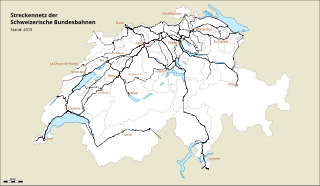
Swiss Federal Railways is the national railway company of Switzerland. It is usually referred to by the initials of its German, French, and Italian names, either as SBB CFF FFS, or used separately. The Romansh version of its name, Viafiers federalas svizras, is not officially used.

The RABDe 500, is a Swiss high speed passenger train which was introduced in 2000, in time for Expo.02 held in western Switzerland in 2002. Its maximum speed is 200 km/h (120 mph), which can be reached on the Mattstetten–Rothrist new line; as of 2018 the RABDe 500 uses the branch to Solothurn only; the ICNs reach 200 km/h in the new Gotthard Base Tunnel. The train sets were a joint development by Bombardier, Swiss Federal Railways and Alstom, with an aerodynamic body designed by Pininfarina, bogies and tilting mechanism designed by the then SIG, Schweizerische Industrie Gesellschaft.
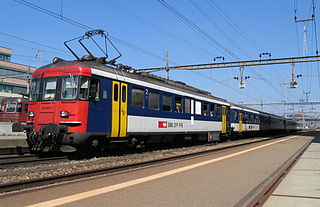
Starting in 1959, the SBB motor coach of the type RBe 4/4 was for a replacement of the old SBB electric locomotives Ae 3/6 I, Ae 3/6 II, Ae 3/6 III and SBB Ae 3/5 with three driving axles. As a consequence, they had much power at their disposal, even more than the Re 4/4 I locomotives, a regenerative brake, cabs on both ends with doors to passenger carriages as well as Multiple-unit train control SBB Vst IIId for multiple-unit or driving trailer. They originally motor coach had 64 seats, 32 smoking and 32 non-smoking, and were painted in ordinary SBB green.

The Tösstal railway line is a railway in the Swiss canton of Zürich, which serves the communities of the Töss Valley. Passenger service on the line now forms part of the Zürich S-Bahn, branded as the S26, and the standard Zürcher Verkehrsverbund (ZVV) zonal fare tariffs apply to the line. It is one of the network's less-heavily traveled lines, and most of the route is single-tracked.
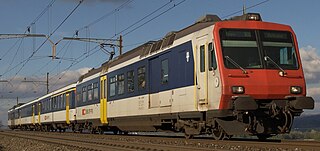
The RBDe 560 and its derivatives provide motive power for S-Bahn, suburban, and regional traffic on the Swiss Federal Railways (SBB) network. The derivative versions belong to the SBB as well as various private railroads. The locomotive and its matching Bt model Steuerwagen form compositions generally known as the Neuer Pendelzug, which is the source of the acronym NPZ. An NPZ trainset usually includes one or more intermediate cars.

The RABDe 12/12 is a threepart electric multiple unit used for commuter traffic by the Swiss Federal Railways SBB-CFF-FFS. The trains were put into service in the late 1960s and were in S-Bahn service around Zurich until December 2008.

A control car, cab car, control trailer, or driving trailer is a generic term for a non-powered railroad (US) or railway (UIC) vehicle that can control operation of a train from the end opposite to the position of the locomotive. They can be used with diesel or electric motive power, allowing push-pull operation without the use of an additional locomotive. They can also be used with a power car or a railcar. In a few cases control cars were used with steam locomotives, especially in Germany and France.

The Glarner Sprinter was a named passenger train of the Swiss Federal Railways (SBB). It ran from Zurich into the canton of Glarus, and was operated as a RegioExpress service. The train provided a commuter service for passengers travelling from the towns and villages of Glarus to the greater Zurich region, whilst also providing a tourist connection in the opposite direction. In July 2014 it was replaced by a more frequent service as part of the Zürich S-Bahn, the S25.
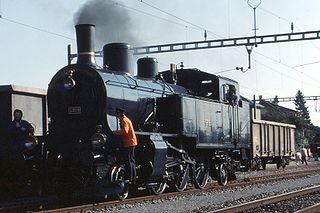
For more than a century, the Swiss locomotive, multiple unit, motor coach and railcar classification system, in either its original or updated forms, has been used to name and classify the rolling stock operated on the railways of Switzerland. It started out as a uniform system for the classification and naming of all rolling stock, powered and unpowered, but had been replaced and amended by the UIC classification of goods wagons.

Stadler FLIRT is a passenger multiple unit trainset made by Stadler Rail of Switzerland. The baseline design of FLIRT is an electric multiple unit articulated trainset that can come in units of two to twelve cars with two to six motorized axles. The maximum speed is 200 km/h (120 mph). Standard floor height is 57 cm (22.4 in), but 78 cm (30.7 in) high floors are also available for platform heights of 76 cm (29.9 in).

The Stadler KISS is a family of bilevel electric multiple unit commuter trains developed and built since 2008 by Stadler Rail. As of 2016, 242 KISS trainsets comprising 1,145 cars have been sold to operators in nine countries.
The Wiese Valley Railway is a 27.2 km long, electrified main line in German Baden-Württemberg in the tri-national area of Germany, Switzerland and France near the Swiss city of Basel. It is part of the Basel trinational S-Bahn and referenced as S6. It runs alongside the river Wiese from Basel Badischer Bahnhof in Basel to Zell (Wiesental). It is operated by the Swiss Federal Railways (SBB CFF FFS)

The Südostbahn – commonly abbreviated to SOB – is a railway company and 1,435 mmstandard gauge network in Switzerland.
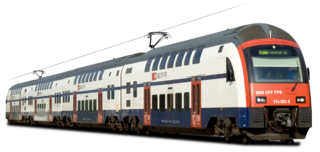
The RABe 514 is a four-car double decker electrical multiple unit used by the Swiss Federal Railways SBB-CFF-FFS for the Zürich S-Bahn. It is part of the Siemens Desiro Double Deck product family. The trains are also referred to as DTZ which stands for the German word Doppelstocktriebzug.

The Brig-Visp-Zermatt-Bahn Deh 4/4, now known as the Matterhorn Gotthard Bahn Deh 4/4 21–24, is a four member class of metre gauge, rack rail, electric multiple unit power cars operated until 2002 by the Brig-Visp-Zermatt-Bahn (BVZ), and since then by its successor, the Matterhorn Gotthard Bahn (MGB), in the Canton of Valais, Switzerland.
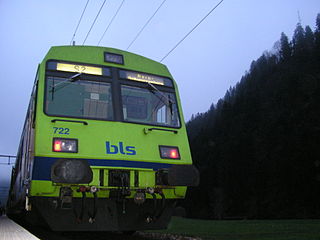
The Bern S-Bahn is an S-Bahn commuter rail network focused on Bern, the capital city of Switzerland. The network is roughly coterminous with Bern's urban agglomeration.

The Zug Stadtbahn is an S-Bahn-style commuter rail network centred on Zug, Switzerland.

The Aargau S-Bahn is an S-Bahn-style regional rail network serving the canton of Aargau, Switzerland.
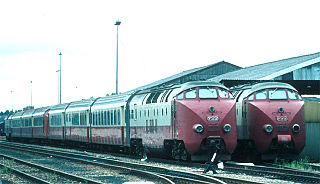
The SBB-CFF-FFS RAm TEE I and NS DE4 were a class of five 4-car diesel-electric trainsets ordered for Trans Europe Express (TEE) service. Two were ordered by the Swiss Federal Railways (SBB-CFF-FFS) and three by Nederlandse Spoorwegen (NS)



















